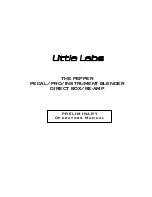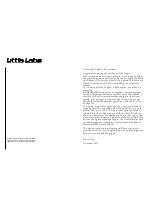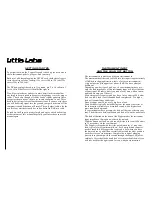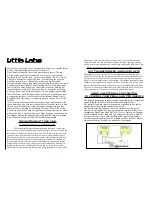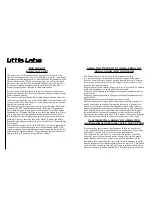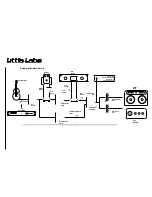
in. Provided your pedals have a proper hard bypass you should still be
nulled, if not adjust the pro return level until it is.
Next, deselect the pedal insert and select the pro insert. The pro
device can be any line level balanced piece of gear, for example
anything in a 500 series rack (not a mic pre though...Duh..), a LA2A
a Pultec, a Distressor, you get the idea. If re-amping, the pro gear
would be pro tools or a channel of a mutli track tape machine.
Ok now, turn up the pro send until you're hitting the pro device with a
healthy level (on pro tools or any recording device select input moni-
tor) if you'll be using pedals too, insert your pedals by pushing pdl
insert with the effects off, Then if you have to, adjust the pro return
until you have a null. With analog gear (like an analog tape machine)
this will always work. With pro tools, because of slight latency even
on input you just have to adjust level for the thinnest sound. On my
Korg MR-1000 the latency is too much and you can't null it at all, oh
well 8-(.
Now you can take the polarity reverse button out and turn down the
instrument thru. You can rest assured the level with the inserts in and
inserts out will remain the same, this might not matter to you that
much, but for re-amping it's absolutely essential. 99% of the reason
people say that their re-amped signal doesn't sound the same as when
playing the part is, the level being off. Done properly, re-amping with
the Pepper, playing the guitar part directly into the amp, and playing
back the part off tape, or DAW, will be indistinguishable.
the instrument thru and
summing it all together
The instrument thru potentiometer labeled instr thru, controls the
level of your dry signal, (bypassing your pedal and pro inserts), that feed the
instrument out and the DI out (mic level out). This is summed together with
your pro return, which controls the level of the post pedal and pro inserts.
This works just like a wet dry mixer. Sometimes your instrument will lack
intelligibility when using effects and blending in a little dry signal can be
just the ticket to give you more attack while still keeping groovy. Parallel
compression is really nice too, take your best pro compressor like an 1176
put that on the pro insert and blend in a little dry for a nice thick sound.
Another use of this instrument thru is when using the pepper to turn a pedal
using an external foot switch
to control your pedal and pro inserts
the di (mic level out)and instrument
out Transformers and earth lifts
The Pepper uses two vintage UTC style transformers for both the direct
out (mic level out) and the instrument out. These excellent transformers are
sealed in mu metal cans so they are shielded from stray electromagnetic
fields, or in more simple terms, air born hum. This makes the pepper highly
suitable for emf plagued live stage work. They also allow you to have com-
plete ground isolation where you need it, to avoid ground loop caused hum.
The earth lift buttons are labeled di earth and instr earth. Push one or both
of these buttons in, if you need to eliminate ground loop hum, .
into pro gear (more on that later). It can be used as a feedback which of
course can send you into horrible oscillation, but used sparingly on delay
pedals, and even an mxr phase 90 can be truly trippy and a whole lot of fun!
The Peppers pedal and pro inserts can be controlled by an external foot
switch. Plug the trs foot switch into the jack labeled ext foot.
The pdl insert and pro insert switches must be pushed in, in order to
control the inserts with the external foot switch.
The dual foot switch you need to use is a standard trs foot switch
which we don't include, but they are cheap and readily available. For
example the Hosa Technology FSC-385 is a very sturdy unit. I bought
one off Amazon for less than 10$. You can get on Amazon, a GLS 25
foot trs to trs cable to use with the Hosa and Pepper for around $15.
No audio runs through the cable so it doesn't need to be fancy. Here is
a diagram of what's needed, you might have one already.

